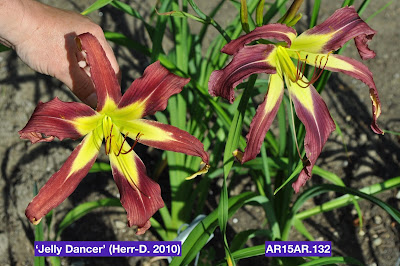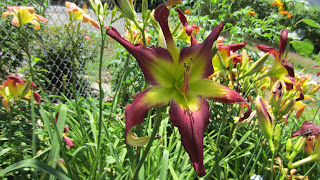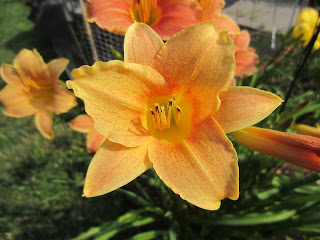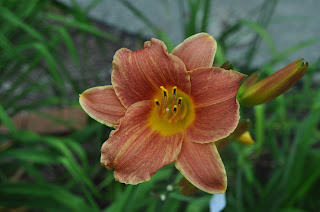A small section of Lori's yard that shows Pequot Pond in the background -- Beautiful!
This past July I had the pleasure of visiting Lori Jones out in Westfield, Massachusetts. She specializes in tetraploid unusual forms and, wow, what a show her garden put on. You can view both her
website and her
blog.
Harmon Hill Farm in Nashua, New Hampshire also sells many of her earlier introductions.
Lori invited me to her garden several years ago at the Region 4 Picnic at Harmon Hill. This summer, I finally made up my mind to visit, and with no regrets! Her garden was around, if not in, peak bloom and, although it was a very hot day, the breeze off of the charming pond was refreshing.
Over the past several years, Lori has been trying to "shake-up" her program by adding all the current bells and whistles to her Unusual Forms: ruffling and teeth. To do this, she has used the genetics from her friend, Mark Labbe, as well as other hybridizers. While perhaps a generation or two away from her ideal goal, her results thus far have been promising!
15-1588
Above is an example of her efforts thus far. This seedling (I have not inquired about the parentage since I neglected to take pollen), while not a UFO, could easily be crossed with something to make it a cascade, crispate etc.. And, if you direct you attention to the left petal of the flower, you will see some little teeth forming. I'm sure next year the teeth will be better for Lori, considering that this seedling was only planted last year.
I did, perhaps, come a tad too early in the season to see the majority of her seedling with teeth, but I was still blown away by her "typical" seedlings and registrations. A few photos:
This photo does not do this plant justice, stunning in a clump, and TALL!
14-930
My favorite from all her seedlings I saw this day. This drew me from across the garden, the color pops THAT much! Has a toothy parent, too! Looks like their might even be some sculpting...
LJ 11-1267 (Whip City Candy Canes)
I don't recall any comments from Lori regarding a possible introduction of this one, but stunning in a clump overlooking the water! Look at that veining! Reminds Lori of a candy cane.
10-888 (Whip City Calypso Disco)
One might think, "Just a simple red" but this notion would be wrong! Lori said she'll register this next year and, if you're looking for a sunfast red, this will be the one to get! Wowed me with its presence!
This is just a small sample of what was showing at "Knoll Cottage" that day. I must say that, although I do not currently work with tetraploid UFOs, I took SO much pollen from Lori's garden because the plants were just that stunning. Even though her seedlings are close together due to limited space (a problem I, too, face!) her plants were still able to preform splendidly. I also, in the past, have seen her plants grown at Harmon Hill and they, too, amazed me with their vibrant colors (and charming names!). There was one last seedling that I wanted to share:
15-1508
This is another one of Lori's seedlings that has a toothy parent. I really am just in love with the color! It was very short with low bud-count but, quite frankly, this means absolutely nothing since this was the first year it bloomed. I'm excited to use this pollen with my yet-to-bloom seedling out of Vampire Fish. Oh the possibilities...
I'll end this post with a few more glimpses of Lori's garden:






































